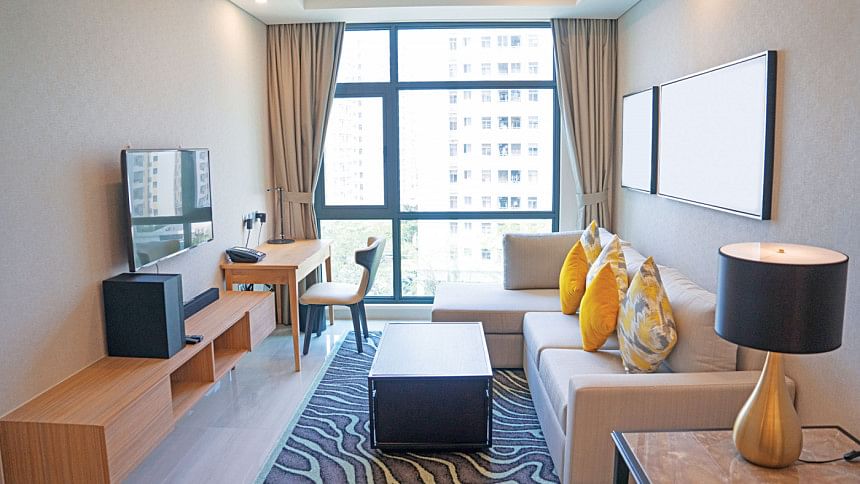Maximize Functionality in Compact Living

Overpopulation and urban density have squeezed the living space of modern apartments to accommodate more people. Modern apartment residents can leverage the art of optimization to turn their compact living space into a functional and beautiful home. Space optimization is not all about fitting furniture into a small area—it is a combination of the right mindset and strategies to create a haven where every square inch works to its fullest potential.
"We always tell our clients that less is more in modern apartments. We try to integrate the similar essence of what our customers require within a minimalistic design–from layout to the type and placement of the furniture they want," mentioned Fardina Faridi, Architect at Best Holdings Ltd.

Optimization while designing or renovating
Space optimization consideration is essential while designing or renovating an apartment to ensure efficient utilization of the whole living space. Clever design hacks and smart layouts can help maximize living space while maintaining comfort and style.
Opt for an open layout
Open layout refers to merging living spaces omitting the walls or doors, which creates a visual sense of expansion and free-flow of air and light throughout the whole area. This type of approach usually integrates the living, dining and kitchen areas into a single wide space. In small apartments, an open-concept plan allows the ease of movement, flexibility and opportunity to multi-task.
"Utilizing open layout, breaking down walls and strategically dividing space into different zones can make your small apartment more spacious and wider," said Quazi Fahima Naz, Architect and Leed Green Associates at Archdoers.
Separate dry and wet zone in kitchen
Another functional strategy is carving the wet zone of the kitchen out of the dry zone, which allows additional benefits in an open layout apartment. Separating the dry zone makes it easier to integrate the space with dining and balcony offering the extension of your functional zone. "Dry kitchen strategy gives you the edge to fit in more storage space and cabinets within the kitchen area. This can make your kitchen more organized and reduce the hassle in finding the right utensils," added Architect Naz.

Utilize drywall partitions
Instead of hard walls drywall partitioning can help create flexible boundaries between different areas. Drywalls are also known as plasterboard and they are lightweight, easy to install and cost-effective. They can efficiently serve the purpose of traditional walls to ensure privacy while offering additional storage space.
"Drywalls are highly efficient for space optimization because not only they can divide the rooms but also function as smart storage solutions. The walls can hold cabinets or shelves within them which can be accessed from both sides of the partition making extra space available for keeping your essentials," said Naz from Archdoers. This type of innovative wall layout transcends traditional boundaries and helps in crafting dynamic, visually appealing, and multifunctional interiors in small living spaces.
Optimization strategies for your current space
You do not have to renovate or rebuild your apartment to make the most of your existing space. Simple strategies like decluttering regularly, using vertical storage solutions, and rearranging furniture can significantly enhance the functionality of your home. Multifunctional and wall-mounted furniture can also help you maximize utility without sacrificing comfort.
Ditch single-purpose furniture
In small apartments, no furniture should be used for only one purpose. Every piece of furniture needs to pull double or even triple duty. Consider a sofa bed, which can serve as both a comfortable seating area during the day and a cozy bed at night. Ottomans with storage capabilities are another excellent choice—they can function as both a coffee table and a place to stash extra blankets or magazines. Modular furniture is also a game-changer. These pieces can be rearranged or expanded based on your needs, making them ideal for dynamic living spaces.
"Choosing a study table which also serves as a cabinet or a dining table that folds away or extendable desks that can transform a living room into a workspace when necessary, can make a huge difference in optimizing space in your apartment. Additionally, a bed which folds up into the wall when not in use, can instantly free up floor space during the day, transforming your bedroom into a living area," added Architect Faridi.
Minimize clutter
Clutter is the enemy of small spaces. To create a more open and inviting environment, it is essential to minimize the number of items in your apartment. Start by decluttering and only keeping the essentials. Adopting a minimalist approach will not only make your space feel larger but also reduce stress and create a more peaceful living environment. Architect Faridi mentioned, "One way to minimize clutter is by implementing the "one in, one out" rule. For every new item you bring into your home, make sure to remove one." This prevents your space from becoming overcrowded. Additionally, consider using storage solutions like baskets, bins, and shelves to keep items organized and out of sight.
Get creative with vertical space
Vertical space is often underutilized in small apartments, but it offers a wealth of storage and design opportunities. Installing shelves high up on the walls can help you store books, decorative items, and everyday essentials without taking up valuable floor space. Consider using tall bookshelves, wall-mounted cabinets, and wall hangers to make the most of your vertical space. In the kitchen, you can hang pots and pans from a ceiling rack, freeing up cabinet space. The goal is to think vertically and use every inch of your apartment wisely.
Mark your territory
In a small apartment, it's important to define different areas for different activities, even if you're working with a single open space. Creating zones helps establish a sense of order and makes your apartment feel larger. You can do this by arranging furniture in a way that delineates each area.
For instance, use a sofa or a bookshelf to create a visual separation between your living and dining areas. A rug can also help define a specific zone, such as a reading nook or a workspace. By creating distinct areas for sleeping, eating, and relaxing, you'll make your small apartment feel more organized and functional.
Prioritize open space
While it is tempting to fill every corner of a small apartment with furniture or decor, leaving some open space is crucial for maintaining a sense of balance and flow. Prioritizing open space doesn't mean you have to sacrifice style. Instead, focus on creating a few well-curated vignettes rather than overcrowding your apartment with decor. For example, a simple gallery wall, or a few carefully chosen plants can make a big impact without overwhelming the space. By keeping your apartment open and airy, you'll enjoy a more peaceful and inviting home.
"Just because your apartment is small doesn't mean it can't reflect your personality and style. In fact, a well-curated space that showcases your tastes can make your apartment feel like a true home. Choose decor that you love, but be mindful of scale and proportion," suggested Naz.
Space optimization does not have to be costly or stressful, choose the strategies which are most convenient and relevant for your living space. With a little creativity and thoughtful planning, your small apartment can become a sanctuary that perfectly suits your lifestyle.

 For all latest news, follow The Daily Star's Google News channel.
For all latest news, follow The Daily Star's Google News channel. 



Comments